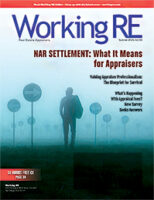 |
> The Appraiser Coach
> OREP E&O |
What’s Happening With Appraisal Fees? New Survey Seeks Answers
by Tony Jones, Senior Editor
While appraisal volume is varying widely by location, the prevailing general consensus in the market today is that appraisal fees are under pressure nationwide. What’s been characterized as the slowest time in appraisal history has no doubt contributed to the downward pressure on fees, but just how much compression has taken place across the nation is difficult to say.
To try to gauge where “customary and reasonable” fees are landing and help appraisers strategically adjust pricing within the markets they serve, OREP/Working RE is launching a nationwide survey to collect data straight from the source. The 2024 Appraiser Fee Survey is the fourth such exercise the company has conducted in the last 14 years, offering appraisers across the country the opportunity to anonymously share what they’re experiencing in their markets and then mine the data collected to adjust accordingly.
Historical Perspective
To better understand how markets are performing currently, it helps to retrace where we’ve been. Our first survey in 2010 was launched in the wake of the Home Valuation Code of Conduct (HVCC) and the rise of appraisal management companies (AMCs). Go to WorkingRE.com/Surveys to view past Customary and Reasonable Fee Surveys. At that time, the fee issue had grown in importance due to appraisal independence mandates in Dodd-Frank, and nearly 18,000 appraisers participated—many of whom were struggling to cope with severe fee splits they were facing from opportunistic AMCs. This proved to be a pivotal turn, and many licensed appraisers could no longer afford to stay in business.
When the second survey launched in 2017, drawing more than 7,000 participants, the tide for many appraisers had begun to turn and fees were rising, though this was largely credited to years of sector erosion and a severe thinning of the ranks. Still, the turnaround was vindication for many longtime appraisers who managed to push forward despite the litany of adversities spearheaded by the Great Recession and collapse of the housing market.
The third survey, conducted in 2021, came after an unprecedented surge in business was ushered by the COVID-19 pandemic. With about 30 percent fewer licensed appraisers operating nationally compared to 2010, 2020 had been a boon for total mortgage originations and appraisal volume. In fact, Freddie Mac reported that the seven-month stretch at the outset of the pandemic (March to September 2020) represented the seven highest volume months on record in terms of appraisals received via the Uniform Collateral Data Portal (UCDP), the submission platform used by Freddie Mac and Fannie Mae that facilitates the electronic collection of appraisal report data.
By the time the 2021 survey was launched, the boost in volume, coupled with a stabilized pool of appraisers available to complete assignments, suggested appraisal fees were increasing in many markets. This was supported by lenders reporting longer turn times and fee bumps in high-volume markets as well as appraisers who indicated they had raised their fees in response to the higher demand.
Knowing what’s occurring on a national scale provides some context and a baseline by way of comparison, but when it comes to actually setting fees, reality rests within the dynamics of every local market. For example, tracking the prevailing appraisal fees in Bend, Oregon, follows the path of expectation through the first three surveys. In 2010/2011, appraisers in Bend were earning a typical fee of $401-$450 for a standard 1004 (single-family detached) order. By 2017, the typical fee in Bend ballooned to $651-$700, and in 2021, the benchmark had pushed past the $751 mark.
By comparison, appraisal fees in the Miami metropolitan market followed a similar path over the same time frame, though not as positively pronounced or well-defined. In 2010/11, the typical fee for a standard 1004 was slotted evenly between $301-$350 and $351-$400. In 2017, it was an even split between $351-$400 and $401-$450, suggesting some modest improvement. In 2021, the typical fee had settled in the $451-$500 range.
This type of comparative data is available to all appraisers and industry stakeholders for free at WorkingRE.com. The fourth installment of the fee survey should give appraisers a snapshot of how colleagues and competitors are adjusting to present conditions occurring within the markets they serve, but the value of the data will be dependent on the level of participation.
(story continues below)
(story continues)
Fee Pressures Persist
What’s occurring across the nation currently is decidedly a mixed bag. Whereas fees were increasing incrementally in many markets during the last two surveys, the general sense right now is appraisers have been hit by a steady array of factors persistently pushing fees downward. Just how much and where are key motivators for collecting new data?
In terms of big-picture numbers, a 2023 fact sheet from the Appraisal Institute indicates there are roughly 70,000 individual licensed and certified appraisers, though that figure is down about 8,000 from 2022. Further, 75.7 percent of appraisers have spent more than 15 years in the valuation profession, while just 8.8 percent have joined the ranks in the last five years. This supports the popular notion that mass attrition continues to occur throughout the profession without significant replenishment from new trainees. As experienced appraisers retire or simply exit the market in search of other/better income, the net loss is glaring.
Even as the number of appraisers continues to decline (slightly), appraisers continue to face fee pressure because low inventory gives AMCs additional leverage to play individual appraisers against each other. According to a survey by the National Association of Realtors (NAR), many appraisers are clearly feeling the pinch, with 47 percent of survey respondents citing “fee pressures” as being among their greatest business challenges last year. This stands in stark contrast to just 27 percent in 2022. While the causes of those pressures can be varied, comments collected by NAR indicated AMCs were the primary source of frustration, according to the survey analysis.
This is in line with NAR’s 2022 survey results, in which 54 percent of appraisers said AMCs were among their biggest business challenges.
The Bidding Conundrum
Of course, independent appraisers’ annoyance with AMCs is hardly new. This includes the email-blast bidding process that some AMCs use to fill orders. In this scenario, an AMC emails its preferred list of appraisers in a given area, detailing a particular property and inviting those appraisers to bid on the order—providing their proposed fee and turn time. In some instances, the email is sent to multiple appraisers at once and AMCs are often accused of selecting the lowest bidder. In other cases, the AMC will broadcast an order offering a low fee and the first appraiser to accept the low fee gets the order.
The problem with this model is it treats the appraisal fee and turn-time as the only material factors in the selection of the appraiser, ignoring the experience, skill and, in some cases, the geographic competency of the appraiser.
In many cases, appraisers have aired their grievances online with colleagues, venting about the process and its effect on fees. “I am really getting tired of bidding on work and having to look up the details of the home before bidding,” one appraiser noted in April 2023 to a professional group on Facebook. “At one time, the lender had to fill out an information sheet when submitting work to my company. If they wanted me to look up details, it was called a paper search, and my fee was $75 for this service. Now, I have to look up details on five to 10 properties a day and not get paid anything for it. Even worse, most of the time I do not get the appraisal because I refuse to work for free.”
The appraiser went on to opine that any collective determination of what a fair fee might be is often construed as “price fixing,” while other types of businesses routinely are able to see what competitors charge for services as a matter of normal business practice. “Something has to happen to value our profession, and the newbies need to stop working for free to get more business,” the appraiser wrote. “[I have] 18-plus years in this profession, and appraisers are still accepting fees that I was getting paid more for 18 years ago. Shameful.”
(story continues below)
Assessing Volume
Appraisal volume through the government-sponsored enterprises (GSEs), Fannie Mae and Freddie Mac, can also be an indicator of where fees are lying. Through the first three months of the year, purchase and refinance volumes were about on par with where they were in 2023, according to UCDP figures, but the number of active GSE appraisers also has been increasing steadily since hitting a historic low last December and was back above 30,000 at the end of March, according to an April “Appraiser Capacity” report from Freddie Mac.
What that means in terms of GSE appraisals per appraiser depends heavily on where you’re located. Through the first quarter, the top 10 states for volume, particularly the top four of Nevada (57), Florida (51), Texas (49) and Georgia (48), are all well above the 37.81 average. As a result, we’d expect fees to be competitively high or holding steady in those markets.
Conversely, the bottom 10 markets are all below 30 appraisals per appraiser, with North Dakota (18), Vermont (20), Alaska (21), Washington, D.C. (21) and Wyoming (22), occupying the bottom five rungs.
According to February 2024 figures from the American Enterprise Institute (AEI), which tracks the mortgage and appraisal production numbers of Fannie Mae and Freddie Mac, total GSE valuations tallied 114,802 for the month. Of those, 16,316 were comprised of appraisal waivers and property data collections (PDCs), leaving 98,486 appraisals for the GSEs. With about 32,000 appraisers active on UCDP in February, that equates to about 3.1 appraisals per appraiser.
Though appraisal waivers and PDCs are potential factors in taking work away from appraisers and placing stress on fees, their current impact appears to remain relatively small. In February, for example, waivers accounted for about 11.7 percent of GSE valuations, according to AEI data, which is a little less than the 12 to 13 percent that was trending late last year. The GSE “Appraisal Waiver Plus Property Data Collection” options are even less impactful. In terms of the total valuations (including waivers) the GSEs processed in February, PDCs comprised about 2.5 percent, according to AEI, though it’s worth noting that figure is up from the less than 1 percent that was trending through much of last year.
Though this volume snapshot doesn’t account for volume occurring through the Department of Veteran Affairs, the Federal Housing Administration, private lender appraisal work, direct lender appraisals, or commercial appraisals that exist outside the GSE’s domain, it’s still representative of more than 60 percent of the market and a reasonable barometer for the market as a whole.
Survey Participation
All of this is to say that collecting new data on where appraisal fees are landing currently is warranted and a valuable pursuit. Hard numbers are always better than speculation, but data value is wholly dependent on survey participation.
Similar to our three previous fee surveys, this new installment is broken out by 365 Metropolitan Statistical Areas (MSAs) as defined by the U.S. Census Bureau, with rural areas included by state. It focuses on eight different appraisal products, including reviews and FHA appraisals.
Similar to three years ago, the survey also asks appraisers for input on:
- If (and by how much) appraisers are lowering their fees for desktop and exterior-only assignments
- Current fees for 1004D Appraisal Update Assignment
- Current fees for 1004 Certification of Completion
- Estimated reasonable fees for Fannie Mae’s 1004 “Desktop” form
- Estimated reasonable fees for Fannie Mae’s 1004 “Hybrid” form
In addition, the survey addresses appraisal turnaround time, which some believe directly correlates to report quality. Though Working RE‘s first survey in 2010 included only non-AMC appraisal reports, the new survey draws no distinction between AMC and non-AMC appraisals. It also assumes assignments that are not complex (complex assignments require higher fees).
With the cyclical nature of the market, now’s the time to gauge what’s happening within the specific areas you serve. Survey participation is anonymous and takes only a few minutes to complete. To weigh in with your customary and reasonable fees for various products, click here. Once you’ve completed the survey, we encourage you to send the survey link to as many appraisers as possible encouraging fellow colleagues to contribute.
The initial results should be published by Oct. 1 and will be updated regularly as the various market areas become more populated. In addition to individual appraisers, AMCs can use the data to measure the customary and reasonable fees they offer as well as turn-time policies. The data will be accessible to the government, AMCs and the public at large.
Follow Working RE for C&R Fee Survey Updates:
Facebook.com/WorkingRE
Linkedin.com/Company/WorkingRE
About the Author
Tony Jones is senior editor of Working RE magazine, published by OREP, a leading provider of E&O insurance for real estate professionals. Based in San Jose, California, he has nearly 30 years of business publishing experience and graduated with a bachelor’s degree in journalism from the University of Arizona. To reach him, email tony@orep.org.
OREP Insurance Services, LLC. Calif. License #0K99465





by Stephen Ihrig, SRA
You are asking “What is my customary and reasonable fee for [insert appraisal product here]……”. The wording for the questions are misleading. The questions do not distinguish if you are asking the appraiser to report what their opinion of a customary and reasonable fee is, or what they are actually receiving for fees.
We receive lender (conventional & FHA) from AMCs and direct from lenders. The fees for these two sources are significantly different. AMCs pay about 30% – 40% +/- less for an appraisal than direct lender work. I think the fees from these two different sources should be differentiated. Direct lenders typically pay $550 – $650 for the same appraisal that an AMC will pay the appraiser $350 – $400 +/- for. AMC’s also charge the appraiser typically $10 – $35 +/- to deliver the appraisal, further reducing the fee to the appraiser.
Is the question asking the appraiser to report what the appraiser’s customary and reasonable fee is, or what they are actually receiving? There is a big difference between what appraiser’s were receiving from AMC’s 6-12 months ago and what they are receiving now, it is about 25% +/- less in my area. Direct lender fees have remained consistent. This is another reason these fees should be separated. I responded with the fees I am seeing from AMC’s because the majority of appraisal work is distributed by an AMC. Note, if the fee provided by an AMC’s is lower than all other sources of appraisal work, is it appropriate to consider AMC fees customary and reasonable?
The survey does not address private work. We are consistently busy doing private work at fees nearly double what an AMC provides. This should be included in the survey so appraisers see that they do not have to accept suppressed AMC fees.
I would like to see a more in-depth analysis of what fees are and what a customary and reasonable fee actually is. An appraisal of appraisal fees so to speak.
-by Josh Tucker
This survey won’t be reliable and won’t be compliant with TILA. When discussing customary and reasonable fees it clearly states under section 129 E Truth in Lending Act that AMC fees are to be excluded from studies.
(3) Alternative presumption of compliance. A creditor and its agents shall be presumed to comply with paragraph (f)(1) of this section if the creditor or its agents determine the amount of compensation paid to the fee appraiser by relying on information about rates that:
(i) Is based on objective third-party information, including fee schedules, studies, and surveys prepared by independent third parties such as government agencies, academic institutions, and private research firms;
(ii) Is based on recent rates paid to a representative sample of providers of appraisal services in the geographic market of the property being appraised or the fee schedules of those providers; and
(iii) In the case of information based on fee schedules, studies, and surveys, such fee schedules, studies, or surveys, or the information derived therefrom, excludes compensation paid to fee appraisers for appraisals ordered by appraisal management companies, as defined in paragraph (f)(4)(iii) of this section.
AMC Fees need to be excluded from this survey in order to comply with the law and used as a C&R study.
-by Stephen Ihrig
Thank you for posting this. Great Information.
-by Mary T Thompson
I am so glad I am now officially out of the lender business as of June 1st. In all of 2024 so far I had 95% personal business (prior to this it was 80%+ personal business). So it was an easy decision to DUMP lenders moving forward. Good luck out there, the climate for doing lender business, not to mention crap fees in many cases, is too risky! With personal business, you can charge your worth and for the most part the client does not question your expertise or value and they never ask you for a ROV with 5 more sales to review!
-by Ann M Sampson
What is ignored is what the borrower is paying for an appraisal. The fee to the borrower has not changed or been reduced. Same total fee, but less to the appraiser and more to the AMC.
-